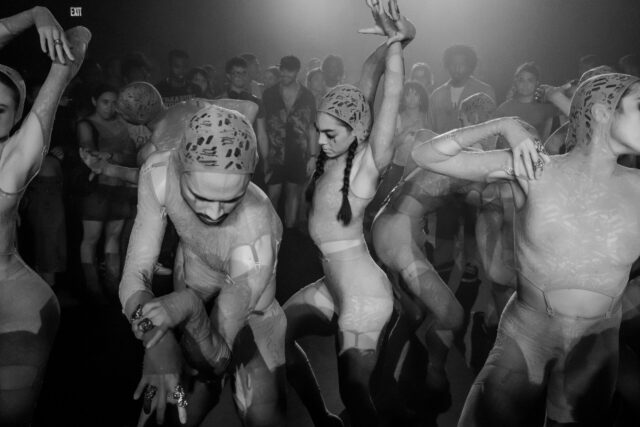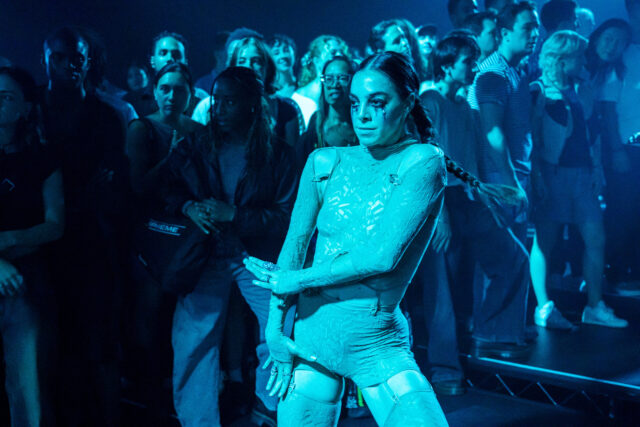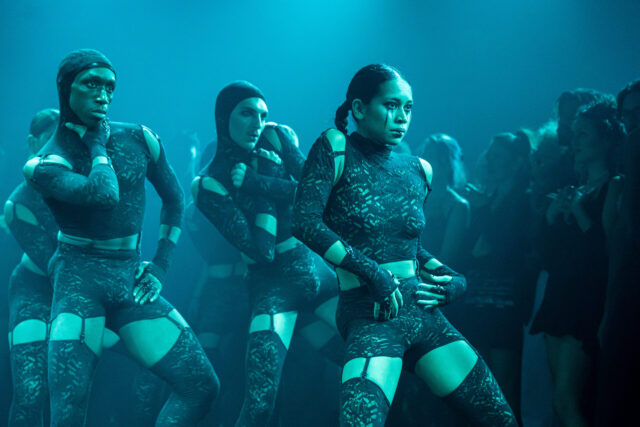
Park Ave. Armory has been transformed into a rave club for R.O.S.E. (photo by Stephanie Berger)
R.O.S.E.
Park Ave. Armory, Wade Thompson Drill Hall
643 Park Ave. at Sixty-Seventh St.
September 5-12, $65
www.armoryonpark.org
Sharon Eyal’s exhilarating R.O.S.E., which opened September 5 for a too-brief seven-show run in Wade Thompson Drill Hall in Park Ave. Armory, ebbs and flows as a participatory dance experience that pulses with a series of slow fuses that explode about half a dozen times over the course of three hot hours.
An armory commission that debuted last year at New Century Hall in Manchester, R.O.S.E. starts off calmer than one might expect. The hall is divided into front and back sections by a floor-to-ceiling side-to-side black fabric wall. As the audience arrived in the first section of the hall, about a half hour before showtime, a DJ spun droning tunes in the space, mostly empty save for a few couches and benches; a projection of a large white rose glowed on the wall behind the DJ.
On opening night, one man moved slowly back and forth to the music as a handful of others relaxed, talked, and checked their phones. Little was going on; excitement was nonexistent. At 7:30, the crowd began entering the main space; staff wearing glow sticks placed a sticker over each person’s phone camera lens, as absolutely no photo or video is allowed inside.
The truncated area lacks the breathtaking awe of the hall’s usual vastness, with walls and curtains on all sides and lights and speakers hanging down, blocking the view of the impressive ceiling. There are four step-platforms, with bars in two corners, the tech crew in a third, and DJ Ben UFO in the fourth. (The set design is by Daphnée Lanternier, who is also credited with creative direction.)

Dancers weave in, through, and around the crowd in Sharon Eyal’s immersive R.O.S.E. (photo by Stephanie Berger)
It was not clear what to do at first as attendees considered where to stand. (I recommend hanging around wherever you see white tape on the floor.) The crowd consisted of people from all age groups (except children), in all types of dress and hairstyles, including small groups that appeared to come straight out of SNL’s old “Sprockets” skits; some swayed to the music, others chattered away, and a few scanned their phones. After about fifteen curious minutes, one gentleman stepped into a spotlight in the middle of the room and clapped his hands over his head several times; that was all it took to get more people to start dancing.
Shortly after eight o’clock, as the packed dance floor was heating up, nine performers (Darren Devaney, Guido Dutilh, Juan Gil, Alice Godfrey, Héloïse Jocqueviel, Johnny McMillan, Keren Lurie Pardes, and Nitzan Ressler) entered the space, making their way through the audience, which parted to let them pass. Wearing postapocalyptic beige costumes by Maria Grazia Chiuri of Christian Dior Couture (that occasionally included cowls and cinch sacks), metal jewelry and makeup by Noa Eyal Behar (that featured streaked black eyeliner, teardrops, and piercings), they moved through the crowd with insectlike precision, their arms and legs forming awkward angles.
Eyal cut her teeth as a member and choreographer of Batsheva Dance Company, and her exciting movement language contains elements of former Batsheva artistic director Ohad Naharin’s Gaga system. The work is codirected by Eyal’s longtime collaborator Gai Behar, whom Eyal met in a club in the late 1990s, and Caius Pawsom of the Young art collective.
While some audience members hung back on the platform risers, others followed the nine dancers around the room as the music thumped, haze wafted over everyone, and Alon Cohen’s propulsive lighting shifted between darkness and light. And then the dancers disappeared.

A team of twelve dancers in black join the fray at Park Ave. Armory (photo by Stephanie Berger)
This pattern happened five or six times during the evening. The dancers would sneak into the area, starting from different corners, and groove for between five and fifteen minutes, sometimes breaking off into stunning solos. If you decide to remain close to them, you have to stay vigilant, as they unpredictably turn, twist, and reach out; you might be touched — one woman stood her ground, so a dancer made contact with her, while another dancer gently put a hand on a man’s shoulder — and you might even be given a black rose.
For one exquisitely choreographed scene, the nine dancers faced off against twelve dancers in black lace (New York–based Julia Ciesielka, Blu Furutate, Antonia Gillette, Michaella Ho, Destinee Jimenez, Nick LaMaina, Natalie Wong, Nina Longid, Julian Sanchez, Luc Simpson, Kailei Sin, and Jeremy Villas) in an epic battle that evoked both West Side Story and The Warriors (as well as a smidgen of Beneath the Planet of the Apes).
It’s a long night, so if you need a break, you can wander back to the first section or even out into the armory’s various period rooms with chairs and couches, and you can get a breath of fresh air outside, but the time between dances gets shorter and shorter as the evening continues, and you don’t want to miss any of them. Part of the fun is anticipating where the dancers will next emerge from and when and where they will exit. Near the end, there are longer solos and, ultimately, a stirring finale where everyone comes together in a rousing celebration bursting with electricity.
The more you put into R.O.S.E., the more you will get out of it. Don’t take off the phone sticker and try to steal a picture or video, which I saw at least two people doing, and don’t obsessively scroll through your cell in between dances. Get into the groove. Bask in the freedom. Join the party and rave on!
[Mark Rifkin is a Brooklyn-born, Manhattan-based writer and editor; you can follow him on Substack here.]